There’s a new IPO in town and it’s not any stranger to most neighborhood folks who have heard of the brand.
Kimly Limited is inviting man on the street to become part of the shareholders by opening a total of 173,800,000 new shares which comprises of 170,000,000 placement and 3,800,000 public tranche at an offer of $0.25 for each share.
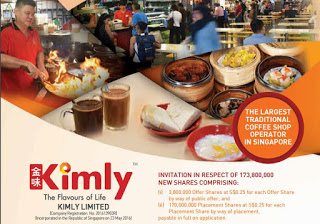
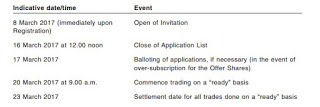 |
| Indicative Timetable |
About The Company
Kimly Limited operates and manages coffee shops chains as the master leaseholder which then lease these food stalls to tenants.
They operates a total of 64 food outlets, which comprises of 56 coffee shops, 3 industrial canteens and 5 food courts.
They also had a central kitchen where all the activities for the food preparation was done at.
The current occupancy rate was at 98% and they own 5.8% market share of the business.
Financials
Let’s first go to see the financials of the company.
The company had a decent cagr growth of 7.6% and 9.9% over the last 3 years. To be frank, this isn’t hard to do when they have the cash to operate more food stalls to lease out given their impressive gross and net margins.
The company boasts an impressive gross margins of 21.5% and net margin of 14%. Do note however that profits attributable to shareholders are around 50/50 with the NCI.
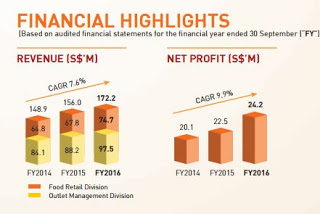
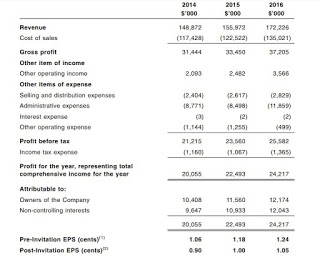
We can see that the company operates under a light asset model.
Cash equivalent makes up around 67% of the total assets and that says all about it.
We can also see that cash turnaround trend is also great when they had such a remarkable less receivables and much higher payable on their books.
That says a lot about their business model.
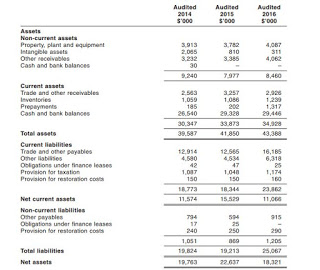
In terms of Cashflow, they are also pretty much cash generative as they have such an impressive free cash flow generated.
Maintenance capex is low and is usually in the form of restoration costs and also some equipment changes.
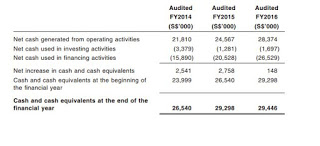
Comparative Business Model
I’ve done some analysis on F&B companies in my past articles and draw up some pretty similar stats.
Kimly do not operate exactly under the same business model as Jumbo, Sakae, Tunglok and Japan food holdings but what we can see from the latter is that only Jumbo makes the cut outright successful in terms of the numbers. The other 3 has such a difficult time trying to reduce their overhead and increase productivity that their net margin remains low. The latter are also asset heavy which drags their roa and roi numbers downwards.
Perhaps it’s better to operate under the Kimly model. It’s asset light and cash generative. Though we are unsure if the options to grow are more limited that way.
Valuations
Valuation of the company is at 12x earnings and 5x book value.
I don’t think it’s the correct way to measure this via book value since they are asset light model so I would measure this via the free cash flow method.
If other F&B companies like Japan Food Holdings can be valued at 20x+ under such a heavy asset model, I think this might be valued higher.
12x earnings would look cheap if the company can grow well over the next 5 years.
My Thoughts
I do not quite understand the need for them to go public when they had so much cash in their book and they are generally cash generative.
I suspect the reason they go public is the need for branding as they are planning to open up an online ordering platform by partnering also with Ubereats and Grabeat.
When they do M&A, branding also plays an important part in tendering process.
With 3.8m shares on the public tranche, investors can expect to get nothing or little. Even if you are lucky, it’ll be at most 3 to 5 lots.
I think this will debut well and will be valued much higher at around 18x earnings. I suspect share price would go to as high as 45 cents before settling down around there. With growth to come over the next few years, it might be well worth to see how well it can run from here, though of course execution risk is another matter altogether.
I’ll try bidding this for fun and see how it goes. Maybe I can earn some free milk powder money in Mar 🙂


Noted the earnings multiple in the article is 12x. To clarify, are you referring to the PE? Based on the offer doc, the PE should be 24x ($0.25/$0.015).
Based on my observations, Small Cap Companies(around $50m) should range around 15x PE. Would this valuation set by the Company be on the high side?
Agreed, it should be $0.25/$0.0105.
Also, the FCF number itself is meaningless without context of the market cap, so I suggest using FCF yield
I think its a bit confusing because they are using pro-forma figures in the prospectus but pg 79 shows that there are premium to the acquisitions of the NCI so after restructuring they should own 100% now.
Ur article has probably just made the ipo 20% more difficult to get now lol
Hi CSCCC
Hahaha 3.8m public tranche is too small indeed.
The business model has a strong ability to generate cash flow, no doubt.
Should the company has not declared any dividend over the years, the company has generated strong free cash flow and high current ratio.
With.. 1,154,800,000 shares will be issued based on the 288.7 million market capitalization.
I think that this company can buy and target price will be $0.57. My call is a Buy. But what may hinder me, that is the weak cash control in the coffee shops at the moment.
Hi Yong Sheng
They would have to given the owners want to reap the profits they had earned into their pocket right? :d
am puzzled why the company has not declared any dividend.
starlight
If I am not mistaken, before IPO, about 50% of gross profit is being distributed to the owners of the company (existing shareholders) as stated in the document. After IPO, they mentioned that not less than 50% of the profit will be paid as dividends which is almost the same about those owners will be receiving previously because they are issuing 173,800,000 shares while existing shares (after stock split) are 980,986,732 shares.
Still very hard to determine if this IPO is juicy or not. If expansion is not aggressive enough and if the locations are not ideal, hard to see a huge difference in the net profit. (Failed to extend lease in one of the food court in one of the Polytechnic)
Actually the risk i see is the short master lease tenure of 3-4 years.
Reits have a longer tenure, some freehold or 99 years or 20-40 years for industrial.
Will it be hard for the a competitor to bid for the HDB master lease when it is up?
I read somehwere that the yield is in the region of 4% given that 50% of netprofit is paid out as dividends.
Given its limited ability to grow which is somewhat like a REITs limited ability to grow, at 4%, 3-4 years tenure.. is it really attractive?
Hi sgdividends
Interesting views there!!!
Both model like this and Reits have inherent risk on their own because longer tenure lease also could end up with unoccupied rate while as master lease landlord you can also have the trouble of having to tender every 3-4 years with competition rising up.
Thanks for bringing up.
Hi B,,
LOL ! I like your last sentence on " earn some free milk powder money " ,,, with you amount of betting ,,, your milk powder must be very expensive,,,, sorry long time never buy milk powder since my kids all grown up,,, 🙂 All the best to this IPO application,,,,
Cheers!
I dont like the masterlease model.
If they owned at least 30% of the coffeeshops, then this model is attractive.
Masterlease not attractive. When landlord up prices, how ? Less coffeeshops, less revenue. If bid too high, margins lesser.
Not sure how much revenue and net profit is generated from Ngee Ann poly Acct?
LHL has listed and private arms, listed arm – Kimly obtain cash and use $$$ to renovation (under IPO proceed), While private arm (LHL is holding 17 outlets lease to kimly which under IPT) can re-value/re-finance their ppty after upgrade and lend more money from bank, then acquire new coffeeshop under private arm and lease back to listed arm -Kimly again…
eToro is the ultimate forex trading platform for novice and advanced traders.
Hi,
This might sound controversial to some people, but remember, I’ve spent half a lifetime surrounded by people who have achieved great success (financial included), so I know what I’m talking about here…
Positive thinking is NOT enough to bring you wealth.
No matter what other self-help experts out there tell you, it is NOT enough.
Positive Thinking by itself = Future disappointment
What you need is…
Positive Thinking + Skills/Mindset + Action = Great wealth
Here’s how to become a complete and total MAGNET for money…
==> The REAL secret to Total Money Magnetism
If you want to become wealthy then you need to learn how to reprogram your mind to THINK like a millionaire.
Society has programmed so many incorrect thoughts about how money works that it takes a lot more than just positive thinking for you to become a magnet for it.
But… If you’re willing to change your way of thinking…
If you’re willing to forget the well meaning advice from your friends, family, school teachers, and so forth……If you’re willing to implant the brain of a millionaire into your head…
Then follow this link while it’s still online:
==> The REAL secret to Total Money Magnetism
I couldn’t recommend this any more highly.
It’s about to change your life for the better, if only you’re willing to take action and follow through with this.
Enjoy!
Kind regards,
[Dr. Steve G. Jones]